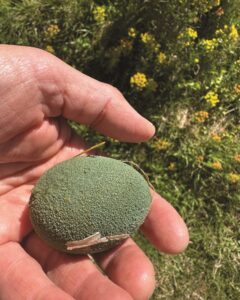TRURO — A small-flock poultry farmer can be forgiven for priding herself on the beauty, health, and productivity of her flock. At least I hope so, because such hubris has overtaken me. Oh, those lustrous iridescent feathers, flaming carmine combs, and fluffy behinds! Then there’s my rock-’n’-roll rooster Aurelius’s operatic crooning. And how about that glorious palette of eggs on offer: chocolate brown or freckled, blushed with pink, a buffy ivory, palest aqua blue, olive or glacial green?
But farming also comes with curious and sometimes inexplicable events. Things that, as the nuns at my Catholic elementary school in Michigan used to suggest, can “take you down a peg or two.” (Including some that might make a reader want to wash her hands thoroughly.)

Like that Friday last fall when, bending low in the garden with my hens rustling in the flagging bean patch nearby, I was afforded a look at the shocking undercarriage of Buttercup, my peach-feathered Buff Orpington. It was a ghastly scene, one that prompted the hasty exit of my carpenter friend Ken Stockdale: “Whoa. If that’s farm livin’ … I gotta go!”
You see, poor Buttercup was trundling around with an egg where it oughtn’t be. It was a sort of inside out or prolapsed egg. While I was able to gently coax the egg intact from its slippery, bloody chute, the fact is that some bits that belonged inside that hen had spent too long on the outside. Sadly, some months later she succumbed, I think due to infection.
The latest egg anomaly involved an egg found where it should be, still slightly warm, and nestled in the fresh straw of a nesting box. Except this egg was wholly encrusted with an alarming bumpy algal green; it looked as if it had been marinating in a primordial soup. Unnerved, I searched the internet, and when it offered up not one image of the sort, I sent a pic to two friends and seasoned chicken tenders, Victoria Pecoraro and Jess Cook.
Neither had ever seen anything like it. “Maybe give her probiotics,” said Vic — just in case that green stuff indicated an overgrowth of flora in her gut. Good thinking. But I have 17 girls and wasn’t sure who laid the egg in question.
The scrape of a fingernail revealed a pale blue color underneath the green coating, so that narrowed the search to one of three hens, Maharishi, Nancy Marie, or Frankie — all of the blue or green egg-laying Ameraucana or “Easter Egger” breed.
Since Nancy Marie had recently been broody for what seemed like a good month, I figured the egg must’ve been hers. Broodiness happens when a hen is overcome with the light- and hormone-driven fixation to sit on and hatch eggs. Hens often pluck feathers from their breasts, stop laying, eating, and even drinking when they’re broody. They act wiggy. Like dehydrated seniors. Was this freakish egg related to her return to laying?

Just to add another layer of intrigue, so to speak, I arrived to collect eggs one day last week to find dear Frankie departing the box where an aqua egg remained — smudged with a thick film of extra powdery blue pigment.
A little research revealed this could be calcium deposits, which can take the form of hardened masses or fine sand-like particles that can easily be brushed off, as these were. Backyard Poultry, one of my go-to places for chicken talk, reports that calcium deposits can often be attributed to a disturbance during shell calcification, which happens while the egg is in the oviduct. “Common disturbances,” a farmer there advises “include a predator, loud thunderstorms, or even a bully hen.”
This made some sense. Although I named her after the very sturdy career waitress with whom all of us kids worked at the local fish joint, my Frankie, I’ll admit, is a delicate flower.
As you gather here, my friends, some farm mysteries remain unsolved, and more will arise. But I can tell you that, in the meanwhile, Ms. Nancy Marie is thoroughly enjoying her daily dose of Seven Stars yogurt.



